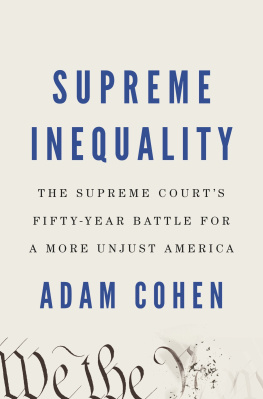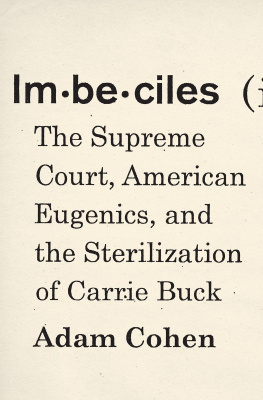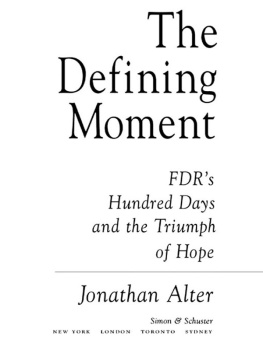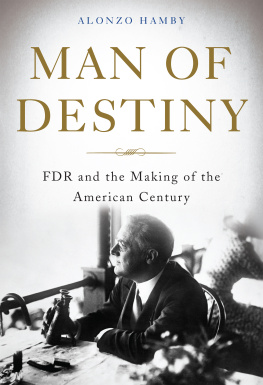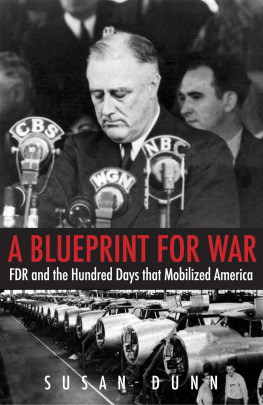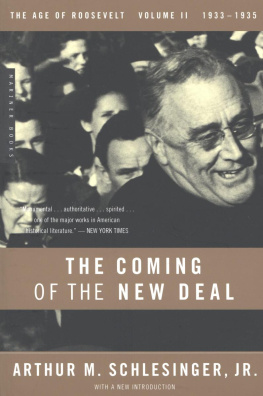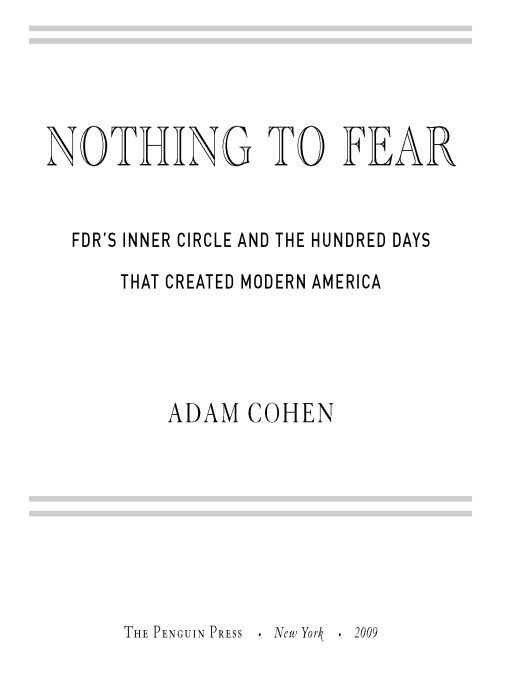Table of Contents
ALSO BY ADAM COHEN
American Pharaoh: Mayor Richard J. Daley:
His Battle for Chicago and the Nation
(with Elizabeth Taylor)
The Perfect Store: Inside eBay
To Beverly and Stuart Cohen
The beginning is the most important part of any work... for that is the time at which the character is being formed.
PLATO, The Republic
INTRODUCTION
Edmund Wilson, the well-known writer, toured Chicago in 1932 and found a sea of misery. On one stop, he saw an old Polish immigrant dying of a tumor, with no heat in the house, on a cold day. In the citys flop-houses, Wilson encountered a great deal of t.b. and spinal meningitis that got out of hand for a while and broke nine backs on its rack. Worst of all were the garbage dumps, diligently haunted by the hungry. In the summer heat, when the flies were thick, a hundred people descended on one dump, falling on the heap of refuse as soon as the truck had pulled out and digging in it with sticks and hands. Even spoiled meat was claimed, since the desperate foragers could cut out the worst parts or scald it and sprinkle it with soda to neutralize the taste and smell. A widowed housekeeper who was unable to find work showed up with her fourteen-year-old son. Before she picked up the meat, Wilson wrote, she would always take off her glasses so that she would not be able to see the maggots.
Wilson could have written a variation on this grim dispatch from any city in America. By 1932, the shock waves of the Crash of 1929 had brought devastation to every corner of the country. One-fourth of the nations workforce was unemployed and Fortune estimated that 27 million Americans were without a regular income. People with jobs struggled to survive on wages that had plunged to near-starvation levels. An Arizona cotton picker could earn as little as thirty cents a week after food and housing were deducted. In the cities, there were long lines outside soup kitchens and plaintive hunger marches by the unemployed. In rural areas, the destitution was less obvious but just as real. The American Friends Service Committee visited the West Virginia and Kentucky hill country and found that up to 90 percent of the children in some schools were underweight, and many were drowsy from malnutrition. Americans were reaching the limit of what they could take. Radicalism was on the march, not only in cities, but in God-fearing parts of the Farm Belt. The biggest and finest crop of little revolutions I ever saw is ripe all over this country right now, a National Farmers Union leader warned.
The nation was crying out for the government to respond, but President Herbert Hoover refused to acknowledge the seriousness of the crisis. I am convinced, he said in the spring of 1930, we have passed the worst. As the Great Depression held on for year after brutal year, Hoover began to concede that the crisis was real, but he still refused to provide the sort of relief that was needed. His free-market ideology taught him that private enterprise should be the source of all solutions, and his near-religious commitment to rugged individualism convinced him that giving aid to the Depressions victims would morally damage them. Hoovers callousness earned him the enmity of the nations millions of unemployed, who got their revenge by turning his name into an epithet. They dubbed the bleak encampments they erected in parks and under bridges Hoovervilles and they called the old newspapers they covered themselves with at night Hoover blankets. When Hoover ran for reelection, mobs of jobless men and women showed up at his campaign rallies and pelted his car with rotten eggs. His opponent, Franklin Delano Roosevelt, promised a new approach. Roosevelts vision of what government should do was so different that Hoover declared the 1932 election to be a choice not between two men, but between two philosophies. Hoovers philosophy lost in a landslide in which he managed to carry just six states.
When Roosevelt took office on March 4, 1933, he charted a new course. That course was determined during the first one hundred days of his presidency. The Hundred Days, as the press would later name the period, began with a remarkable inaugural address. After assuring a despairing nation that the only thing we have to fear is fear itself, Roosevelt promised action, and action now. More than his words and his confident manner, it was the flurry of activity he ushered in that raised the nations spirits. During the Hundred Days, Roosevelt offered up what the historian Arthur M. Schlesinger, Jr., called a presidential barrage of ideas and programs unlike anything known to American history. Roosevelt shepherded fifteen major laws through Congress, prodded along by two fireside chats and thirty press conferences. He created an alphabet soup of new agenciesthe AAA, the CCC, the FERA, the NRAto administer the laws and bring relief to farmers, industry, and the unemployed. In an editorial entitled Laws for Everything, The New York Times declared Roosevelts dizzying pace of accomplishments to be little short of a marvel.
The Hundred Days swept the old order away in quick and dramatic fashion. On inauguration day, the nations banks were teetering on the brink of collapse. Thousands had already failed, and all forty-eight states had declared bank holidays, preventing more banks from failing by cutting depositors off from their money. Hoover had stood idly by, refusing to intervene. Roosevelt took a more active stance. Within days he had declared a national bank holiday and signed the Emergency Banking Act, which immediately put the banking system on a firmer footing. He then delivered a remarkable fireside chat that restored the publics faith in the banking system. When the banks reopened, the public rushed to put money in, not take it out, and the crisis was over. Before the Hundred Days had ended, he signed a second law, the Banking Act of 1933, which made deeper reforms.
When Roosevelt was sworn in, farmers were entering the second decade of their own, localized depression. At the end of World War I, commodity prices had plunged so low that for many farmers it no longer paid to plant. Farms were being lost to foreclosure at an alarming rate, and farm families were being thrown off the land. Hoover had made a few halting efforts to address the problem, but his ideology had prevented him from taking more effective steps. Within weeks, Roosevelt had signed a revolutionary new law, the Agricultural Adjustment Act, which increased farm prices by paying farmers not to grow crops. He combated farm foreclosures through the Farm Credit Administration, a new federal farm mortgage program.
Roosevelt also brought help to the urban unemployed. Hoover, who believed relief eroded character and encouraged idleness, thought the poor should be cared for by private charity or, as a last resort, by local government. Roosevelt created the nations first federal relief program, the Federal Emergency Relief Administration, which supported the unemployed with federal money dispensed according to federal standards. He established two major public works programs. The Civilian Conservation Corps sent 250,000 jobless young people out into nature to plant trees and reclaim the land. The National Industrial Recovery Act allocated $3.3 billion for a wider range of projects. Roosevelt also created an agency, the National Recovery Administration, charged with helping industry get back on its feet. In exchange for that help, he got companies to agree to minimum wages and maximum hours, a legal right for unions to organize, and a ban on child labor.


